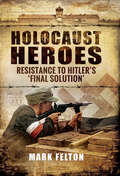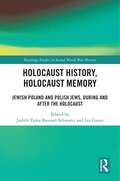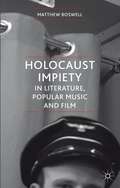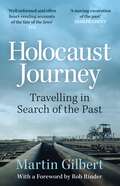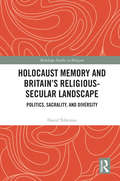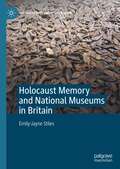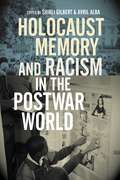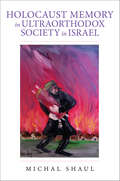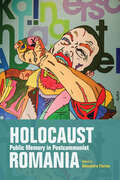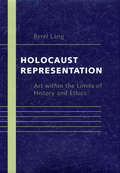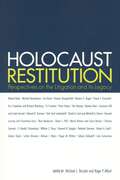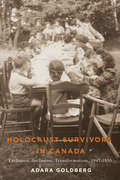- Table View
- List View
Holocaust Heroes: Resistance to Hitler's 'Final Solution'
by Mark FeltonThis inspiring book examines the often incredible and nearly always tragic examples of Jewish resistance in ghettos and concentration camps during the Nazis ‘Final Solution. It shows that the Warsaw Uprising in Poland during April to May 1944 was not the only occasion of defiant opposition. Throughout the Nazis extermination programme Jews and other prisoners fought back against their murderers, often with stunning results. The Germans were nearly always taken by surprise by the sudden emergence of armed Jewish resistance and often paid dearly. This happened in ghettos and concentration campos (including Treblinka, Auschwitz, Syrels and Sobibor) throughout Poland and the Ukraine. Some Jews tried to stop the machinery of the Holocaust by rising up and destroying the gas chambers while others bravely tried to take over an extermination camp and escape en masse. In virtually every case the brave men and women who volunteered to fight back paid with their lives. Importantly these men and women are not just portrayed as victims but also as brave and resourceful fighters and resisters against their tragic fate. These are stories that are uplifting, inspiring and often profoundly moving.
Holocaust History, Holocaust Memory: Jewish Poland and Polish Jews, During and After the Holocaust (Routledge Studies in Second World War History)
by Judith Tydor Baumel-Schwartz Lea GanorThis volume is both a study of the history of Polish Jews and Jewish Poland before, during, and immediately after the Holocaust and a collection of personal explorations focusing on the historians who write about these subjects.While the first three parts of the book focus on "text," the broad nature of Polish Jewish history surrounding the Holocaust, the last section focuses on subtext, the personal and professional experiences of scholars who have devoted years to researching and writing about Polish Jewry. The beginning sections present a variety of case studies on wartime and postwar Polish Jews, drawing on new research and local history. The final part is a reflection on family memory, where scholars discuss their connections to Holocaust history and its impact on their current lives and research. Viewed together, the combination sheds light on both history and historians: the challenges of dealing with the history of an unparalleled cataclysm, and the personal questions and dilemmas that its study raises for many of the historians engaged in it.Holocaust History, Holocaust Memory is a unique resource that will appeal to students and scholars studying the Second World War, Jewish and Polish history, and family history.
Holocaust Holiday: One Family's Descent into Genocide Memory Hell
by Rabbi Shmuley BoteachIn this alternately humorous and horrifying memoir, a Jewish father schleps his reluctant children around Europe on a hard-charging tour of Holocaust sites and memorials in order to impress on them the profound evil of Hitler&’s war against the Jews and the importance of combatting genocide.In 2017, renowned author and celebrity rabbi, Shmuley Boteach, decided to take his family on a European holiday. But instead of seeing the sights of London or Paris, he took his reluctant—and at times complaining—children on a harrowing journey though Auschwitz, Treblinka, Warsaw, and many other sites associated with Hitler&’s genocidal war against the Jews. His purpose was to impress upon them the full horror of the Holocaust so they would know and remember it deep in their bones. In the process, he and his children learn a great deal about the scope and nature of the European genocide and the continuing effects of global hatred and anti-Semitism. The resulting memoir is an utterly unique blend of travelogue, memoir and history—alternately fascinating, terrifying, frustrating, humorous, and tragic. &“It is my honor to contribute a foreword to his important book, in which Rabbi Shmuley Boteach details the excruciating journey he took with his wife and children in the summer of 2017 to the killing fields of Europe, a pilgrimage which every person of conscience should attempt at least once in their lifetime. It is our universal obligation to dedicate ourselves to the memory of the martyred six million, just as it is our obligation to confront and defeat genocide wherever it rises.&” —From the foreword by Amb. Georgette Mosbacher
Holocaust Icons
by Oren Baruch StierThe Holocaust has bequeathed to contemporary society a cultural lexicon of intensely powerful symbols, a vocabulary of remembrance that we draw on to comprehend the otherwise incomprehensible horror of the Shoah. Engagingly written and illustrated with more than forty black-and-white images, Holocaust Icons probes the history and memory of four of these symbolic relics left in the Holocaust's wake. Jewish studies scholar Oren Stier offers in this volume new insight into symbols and the symbol-making process, as he traces the lives and afterlives of certain remnants of the Holocaust and their ongoing impact. Stier focuses in particular on four icons: the railway cars that carried Jews to their deaths, symbolizing the mechanics of murder; the Arbeit Macht Frei ("work makes you free") sign over the entrance to Auschwitz, pointing to the insidious logic of the camp system; the number six million that represents an approximation of the number of Jews killed as well as mass murder more generally; and the persona of Anne Frank, associated with victimization. Stier shows how and why these icons--an object, a phrase, a number, and a person--have come to stand in for the Holocaust: where they came from and how they have been used and reproduced; how they are presently at risk from a variety of threats such as commodification; and what the future holds for the memory of the Shoah. In illuminating these icons of the Holocaust, Stier offers valuable new perspective on one of the defining events of the twentieth century. He helps readers understand not only the Holocaust but also the profound nature of historical memory itself.
Holocaust Impiety in Literature, Popular Music and Film
by Matthew BoswellSurveying irreverent and controversial representations of the Holocaust - from Sylvia Plath and the Sex Pistols to Quentin Tarantino and Holocaust comedy - Matthew Boswell considers how they might play an important role in shaping our understanding of the Nazi genocide and what it means to be human.
Holocaust Journey: Travelling In Search Of The Past
by Sir Martin GilbertIncludes a new foreword by Rob RinderWhat readers are saying about HOLOCAUST JOURNEY:'Brilliant ... A must read for everybody' ⭐⭐⭐⭐⭐'Devastating' ⭐⭐⭐⭐⭐'Fascinating, thought provoking and shocking' ⭐⭐⭐⭐⭐'Everybody should read this' ⭐⭐⭐⭐⭐'Informative and emotional' ⭐⭐⭐⭐⭐In June 1996 Martin Gilbert took a group of students on a two-week journey across middle-Europe which encompassed all the major places in the Holocaust - from Wannsee where the extermination of the Jews was decreed, to the camps themselves, via deserted Jewish communities and synagogues as well as the sites of the ghettos and deportation.'The achievement of Gilbert's HOLOCAUST JOURNEY is to reduce to comprehensible, human terms of the scale of the genocide that to many is still unimaginable' LITERARY REVIEW'Filled with short, well-informed and often heart-rending accounts of the fate of the Jews' TLS'HOLOCAUST JOURNEY travels along the tracks of a history we would rather forget to the sites of wartime horror, and is also a moving excavation of the past' INDEPENDENT
Holocaust Journey: Travelling In Search Of The Past
by Sir Martin GilbertIncludes a new foreword by Rob RinderWhat readers are saying about HOLOCAUST JOURNEY:'Brilliant ... A must read for everybody' ⭐⭐⭐⭐⭐'Devastating' ⭐⭐⭐⭐⭐'Fascinating, thought provoking and shocking' ⭐⭐⭐⭐⭐'Everybody should read this' ⭐⭐⭐⭐⭐'Informative and emotional' ⭐⭐⭐⭐⭐In June 1996 Martin Gilbert took a group of students on a two-week journey across middle-Europe which encompassed all the major places in the Holocaust - from Wannsee where the extermination of the Jews was decreed, to the camps themselves, via deserted Jewish communities and synagogues as well as the sites of the ghettos and deportation.'The achievement of Gilbert's HOLOCAUST JOURNEY is to reduce to comprehensible, human terms of the scale of the genocide that to many is still unimaginable' LITERARY REVIEW'Filled with short, well-informed and often heart-rending accounts of the fate of the Jews' TLS'HOLOCAUST JOURNEY travels along the tracks of a history we would rather forget to the sites of wartime horror, and is also a moving excavation of the past' INDEPENDENT
Holocaust Journey: Travelling in Search of the Past
by Martin Gilbert&“A travelogue, spanning two weeks, of the essential sites of the Holocaust, by the venerable historian and author . . . [A] soul-searching trip&” (Kirkus Reviews). In 1996, prominent Holocaust historian Sir Martin Gilbert embarked on a fourteen-day journey into the past with a group of his graduate students from University College, London. Their destination? Places where the terrible events of the Holocaust had left their mark in Europe. From the railway lines near Auschwitz to the site of Oskar Schindler&’s heroic efforts in Cracow, Poland, Holocaust Journey features intimate personal meditations from one of our greatest modern historians, and is supported by wartime documents, letters, and diaries—as well as over fifty photographs and maps by the author—all of which help interweave Gilbert&’s trip with his students with the surrounding history of the towns, camps, and other locations visited. The result is a narrative of the Holocaust that ties the past to the present with poignancy and power. &“Gilbert . . . is a dedicated guide to this difficult material. We can be grateful for his thoroughness, courage and guidance.&” —Los Angeles Times Book Review
Holocaust Justice: The Battle for Restitution in America's Courts
by Michael J. BazylerThe first book to tell the complete story of the American attempt at restitution for victims of the HolocaustThe Holocaust was not only the greatest murder in history; it was also the greatest theft. Historians estimate that the Nazis stole roughly $230 billion to $320 billion in assets (figured in today’s dollars), from the Jews of Europe. Since the revelations concerning the wartime activities of the Swiss banks first broke in the late 1990s, an ever-widening circle of complicity and wrongdoing against Jews and other victims has emerged in the course of lawsuits waged by American lawyers. These suits involved German corporations, French and Austrian banks, European insurance companies, and double thefts of art—first by the Nazis, and then by museums and private collectors refusing to give them up. All of these injustices have come to light thanks to the American legal system.Holocaust Justice is the first book to tell the complete story of the legal campaign, conducted mainly on American soil, to address these injustices. Michael Bazyler, a legal scholar specializing in human rights and international law, takes an in-depth look at the series of lawsuits that gave rise to a coherent campaign to right historical wrongs. Diplomacy, individual pleas for justice by Holocaust survivors and various Jewish organizations for the last fifty years, and even suits in foreign courts, had not worked. It was only with the intervention of the American courts that elderly Holocaust survivors and millions of other wartime victims throughout the world were awarded compensation, and equally important, acknowledgment of the crimes committed against them. The unique features of the American system of justice—which allowed it to handle claims that originated over fifty years ago and in another part of the world—made it the only forum in the world where Holocaust claims could be heard. Without the lawsuits brought by American lawyers, Bazyler asserts, the claims of the elderly survivors and their heirs would continue to be ignored.For the first time in history, European and even American corporations are now being forced to pay restitution for war crimes totaling billions of dollars to Holocaust survivors and other victims. Bazyler deftly tells the unfolding stories: the Swiss banks’ attempt to hide dormant bank accounts belonging to Holocaust survivors or heirs of those who perished in the war; German private companies that used slave laborers during World War II—including American subsidiaries in Germany; Italian, Swiss and German insurance companies that refused to pay on prewar policies; and the legal wrangle going on today in American courts over art looted by the Nazis in wartime Europe. He describes both the human and legal dramas involved in the struggle for restitution, bringing the often-forgotten voices of Holocaust survivors to the forefront. He also addresses the controversial legal and moral issues over Holocaust restitution and the ethical debates over the distribution of funds.With an eye to the future, Bazyler discusses the enduring legacy of Holocaust restitution litigation, which is already being used as a model for obtaining justice for historical wrongs on both the domestic and international stage.
Holocaust Memory and Britain’s Religious-Secular Landscape: Politics, Sacrality, And Diversity (Routledge Studies in Religion)
by David TollertonBritish state-supported Holocaust remembrance has dramatically grown in prominence since the 1990s. This monograph provides the first substantial discussion of the interface between public Holocaust memory in contemporary Britain and the nation’s changing religious-secular landscape. In the first half of the book attention is given to the relationships between remembrance activities and Jewish, Muslim, Christian, and post-Christian communities. Such relationships are far from monolithic, being entangled in diverse histories, identities, power-structures, and notions of ‘British values’. In the book’s second half, the focus turns to ways in which public initiatives concerned with Holocaust commemoration and education are intertwined with evocations and perceptions of the sacred. Three state-supported endeavours are addressed in detail: Holocaust Memorial Day, plans for a major new memorial site in London, and school visits to Auschwitz. Considering these phenomena through concepts of ritual, sacred space, and pilgrimage, it is proposed that response to the Holocaust has become a key feature of Britain’s 21st century religious-secular landscape. Critical consideration of these topics, it is argued, is necessary for both a better understanding of religious-secular change in modern Britain and a sustainable culture of remembrance and national self-examination. This is the first study to examine Holocaust remembrance and British religiosity/secularity in relation to one another. As such, it will be of keen interest to scholars of Religious Studies, Jewish studies and Holocaust Studies, as well as the Sociology of Religion, Material Religion and Secularism.
Holocaust Memory and National Museums in Britain (The Holocaust and its Contexts)
by Emily-Jayne StilesThis book explores the Holocaust exhibition opened within the Imperial War Museum (IWM) in 2000; setting out the long and often contentious debates surrounding the conception, design, and finally the opening of an important exhibition within a national museum in Britain. It considers a process of memory-making through an assessment of Holocaust photographs, material culture, and survivor testimonies; exploring theories of cultural memory as they apply to the national museum context. Anchored in time and place, the Holocaust exhibition within Britain’s national museum of war is influenced by, and reflects, an international rise in Holocaust consciousness in the 1990s. This book considers the construction of Holocaust memory in 1990s Britain, providing a foundation for understanding current and future national memory projects. Through all aspects of the display, the Holocaust is presented as meaningful in terms of what it says about Nazism and what this, in turn, says about Britishness. From the original debates surrounding the inclusion of a Holocaust gallery at the IWM, to the acquisition of Holocaust artefacts that could act as 'concrete evidence' of Nazi barbarity and criminality, the Holocaust reaffirms an image of Britain that avoids critical self-reflection despite raising uncomfortably close questions. The various display elements are brought together to consider multiple strands of the Holocaust story as it is told by national museums in Britain.
Holocaust Memory and Racism in the Postwar World
by Michael E. Staub Donna-Lee Frieze Tony Kushner Marjorie N. Feld Sarah Phillips Casteel Shirli Gilbert Amos Goldberg Avril Alba Milton Shain Suzanne D. Rutland Dan J. Puckett David Slucki James Jordan Michael Rothberg Bashir Bashir Steven Cooke Dorota GlowackaThe Holocaust is often invoked as a benchmark for talking about human rights abuses from slavery and apartheid to colonialism, ethnic cleansing, and genocide. Western educators and politicians draw seemingly obvious lessons of tolerance and anti-racism from the Nazi past, and their work rests on the implicit assumption that Holocaust education and commemoration will expose the dangers of prejudice and promote peaceful coexistence. Holocaust Memory and Racism in the Postwar World, edited by Shirli Gilbert and Avril Alba, challenges the notion that there is an unproblematic connection between Holocaust memory and the discourse of anti-racism. Through diverse case studies, this volume historicizes how the Holocaust has shaped engagement with racism from the 1940s until the present, demonstrating that contemporary assumptions are neither obvious nor inevitable. Holocaust Memory and Racism in the Postwar World is divided into four sections. The first section focuses on encounters between Nazism and racism during and immediately after World War II, demonstrating not only that racist discourses and politics persisted in the postwar period, but also, perhaps more importantly, that few people identified links with Nazi racism. The second section explores Jewish motivations for participating in anti-racist activism, and the varying memories of the Holocaust that informed their work. The third section historicizes the manifold ways in which the Holocaust has been conceptualized in literary settings, exploring efforts to connect the Holocaust and racism in geographically, culturally, and temporally diverse settings. The final section brings the volume into the present, focusing on contemporary political causes for which the Holocaust provides a benchmark for racial equality and justice. Together, the contributions delineate the complex history of Holocaust memory, recognize its contingency, and provide a foundation from which to evaluate its moral legitimacy and political and social effectiveness. Holocaust Memory and Racism in the Postwar World is intended for students and scholars of Holocaust and genocide studies, professionals working in museums and heritage organizations, and anyone interested in building on their knowledge of the Holocaust and the discourse of racism.
Holocaust Memory in Ultraorthodox Society in Israel (Perspectives on Israel Studies)
by Michal ShaulHow did the Ultraorthodox (Haredi) community chart a new path for its future after it lost the core of its future leaders, teachers, and rabbis in the Holocaust? How did the revival of this group come into being in the new Zionist state of Israel? In Holocaust Memory in Ultraorthodox Society in Israel, Michal Shaul highlights the special role that Holocaust survivors played as they rebuilt and consolidated Ultraorthodox society. Although many Haredi were initially theologically opposed to the creation of Israel, they have become a significant force in the contemporary life and politics of the country. Looking at personal and public experiences of Ultraorthodox survivors in the first years of emigration from liberated Europe and breaking down how their memories entered the public domain, Shaul documents how they were incorporated into the collective memories of the Ultraorthodox in Israel. Holocaust Memory in Ultraorthodox Society in Israel offers a rare mix of empathy and scholarly rigor to understandings of the role that the community's collective memories and survivor mentality have played in creating Israel's national identity.
Holocaust Memory in the Digital Age: Survivors’ Stories and New Media Practices
by Jeffrey ShandlerHolocaust Memory in the Digital Age explores the nexus of new media and memory practices, raising questions about how advances in digital technologies continue to influence the nature of Holocaust memorialization. Through an in-depth study of the largest and most widely available collection of videotaped interviews with survivors and other witnesses to the Holocaust, the University of Southern California Shoah Foundation's Visual History Archive, Jeffrey Shandler weighs the possibilities and challenges brought about by digital forms of public memory. The Visual History Archive's holdings are extensive—over 100,000 hours of video, including interviews with over 50,000 individuals—and came about at a time of heightened anxiety about the imminent passing of the generation of Holocaust survivors and other eyewitnesses. Now, the Shoah Foundation's investment in new digital media is instrumental to its commitment to remembering the Holocaust both as a subject of historical importance in its own right and as a paradigmatic moral exhortation against intolerance. Shandler not only considers the Archive as a whole, but also looks closely at individual survivors' stories, focusing on narrative, language, and spectacle to understand how Holocaust remembrance is mediated.
Holocaust Narratives: Trauma, Memory and Identity Across Generations (Routledge Studies in Comparative Literature)
by Thorston WilhelmHolocaust Narratives: Trauma, Memory and Identity Across Generations analyzes individual multi-generational frameworks of Holocaust trauma to answer one essential question: How do these narratives change to not only transmit the trauma of the Holocaust – and in the process add meaning to what is inherently an event that annihilates meaning – but also construct the trauma as a connector to a past that needs to be continued in the present? Meaningless or not, unspeakable or not, unknowable or not, the trauma, in all its impossibilities and intractabilities, spawns literary and scholarly engagement on a large scale. Narrative is the key connector that structures trauma for both individual and collective.
Holocaust Public Memory in Postcommunist Romania (Studies In Antisemitism Ser.)
by Florian AlexandruHow is the Holocaust remembered in Romania since the fall of communism? Alexandru Florian and an international group of contributors unveil how and why Romania, a place where large segments of the Jewish and Roma populations perished, still fails to address its recent past. These essays focus on the roles of government and public actors that choose to promote, construct, defend, or contest the memory of the Holocaust, as well as the tools—the press, the media, monuments, and commemorations—that create public memory. Coming from a variety of perspectives, these essays provide a compelling view of what memories exist, how they are sustained, how they can be distorted, and how public remembrance of the Holocaust can be encouraged in Romanian society today.
Holocaust Refugees in Oswego: From Nazi Europe to Lake Ontario (American Heritage)
by Ann Callaghan AllenAmerica's Only Shelter Established for Holocaust Refugees/ During the height of the second World War, at the order of President Roosevelt, Fort Ontario in Oswego, New York housed 982 refugees, rescued from the horrors of the Holocaust. The community of Oswego answered the call of service and opened its arms to the survivors. Oswegonian and WWII veteran Joseph Spereno's connection with refugee Jake Sylber helped launch his tailoring business that was a fixture in the city for more than 20 years. Then high school Principal Ralph Faust was among local educators who fought to allow the refugee children into Oswego schools, forging connections with those young people who went on to distinguished careers. Local Boy Scout leader Harold Clark created a troop for refugee children to share in the American experience of scouting.Author Ann Callaghan Allen presents the harrowing narrative of how Oswego gave shelter to hundreds of Holocaust survivors.
Holocaust Representation: Art within the Limits of History and Ethics
by Berel LangSince Theodor Adorno's attack on the writing of poetry "after Auschwitz," artists and theorists have faced the problem of reconciling the moral enormity of the Nazi genocide with the artist's search for creative freedom. In Holocaust Representation, Berel Lang addresses the relation between ethics and art in the context of contemporary discussions of the Holocaust. Are certain aesthetic means or genres "out of bounds" for the Holocaust? To what extent should artists be constrained by the "actuality" of history—and is the Holocaust unique in raising these problems of representation?The dynamics between artistic form and content generally hold even more intensely, Lang argues, when art's subject has the moral weight of an event like the Holocaust. As authors reach beyond the standard conventions for more adequate means of representation, Holocaust writings frequently display a blurring of genres. The same impulse manifests itself in repeated claims of historical as well as artistic authenticity. Informing Lang's discussion are the recent conflicts about the truth-status of Benjamin Wilkomirski's "memoir" Fragments and the comic fantasy of Roberto Benigni's film Life Is Beautiful. Lang views Holocaust representation as limited by a combination of ethical and historical constraints. As art that violates such constraints often lapses into sentimentality or melodrama, cliché or kitsch, this becomes all the more objectionable when its subject is moral enormity. At an extreme, all Holocaust representation must face the test of whether its referent would not be more authentically expressed by silence—that is, by the absence of representation.
Holocaust Restitution
by Roger P. Alford Michael BazylerThe Holocaust was not only the greatest murder in history; it was also the greatest theft. Historians estimate that the Nazis stole roughly $230 billion to $320 billion in assets (figured in today’s dollars), from the Jews of Europe. Since the revelations concerning the wartime activities of the Swiss banks first broke in the late 1990s, an ever-widening circle of complicity and wrongdoing against Jews and other victims has emerged in the course of lawsuits waged by American lawyers. These suits involved German corporations, French and Austrian banks, European insurance companies, and double thefts of art—first by the Nazis, and then by museums and private collectors refusing to give them up. All of these injustices have come to light thanks to the American legal system. Holocaust Justice is the first book to tell the complete story of the legal campaign, conducted mainly on American soil, to address these injustices. Michael Bazyler, a legal scholar specializing in human rights and international law, takes an in-depth look at the series of lawsuits that gave rise to a coherent campaign to right historical wrongs. Diplomacy, individual pleas for justice by Holocaust survivors and various Jewish organizations for the last fifty years, and even suits in foreign courts, had not worked. It was only with the intervention of the American courts that elderly Holocaust survivors and millions of other wartime victims throughout the world were awarded compensation, and equally important, acknowledgment of the crimes committed against them. The unique features of the American system of justice—which allowed it to handle claims that originated over fifty years ago and in another part of the world—made it the only forum in the world where Holocaust claims could be heard. Without the lawsuits brought by American lawyers, Bazyler asserts, the claims of the elderly survivors and their heirs would continue to be ignored. For the first time in history, European and even American corporations are now being forced to pay restitution for war crimes totaling billions of dollars to Holocaust survivors and other victims. Bazyler deftly tells the unfolding stories: the Swiss banks’ attempt to hide dormant bank accounts belonging to Holocaust survivors or heirs of those who perished in the war; German private companies that used slave laborers during World War II—including American subsidiaries in Germany; Italian, Swiss and German insurance companies that refused to pay on prewar policies; and the legal wrangle going on today in American courts over art looted by the Nazis in wartime Europe. He describes both the human and legal dramas involved in the struggle for restitution, bringing the often-forgotten voices of Holocaust survivors to the forefront. He also addresses the controversial legal and moral issues over Holocaust restitution and the ethical debates over the distribution of funds. With an eye to the future, Bazyler discusses the enduring legacy of Holocaust restitution litigation, which is already being used as a model for obtaining justice for historical wrongs on both the domestic and international stage.
Holocaust Restitution: Perspectives on the Litigation and Its Legacy
by Michael J. Bazyler Roger P. AlfordHolocaust Restitution is the first volume to present the Holocaust restitution movement directly from the viewpoints of the various parties involved in the campaigns and settlements. Now that the Holocaust restitution claims are closed, this work enjoys the benefits of hindsight to provide a definitive assessment of the movement.From lawyers and State Department officials to survivors and heads of key institutes involved in the negotiations, the volume brings together the central players in the Holocaust restitution movement, both pro and con. The volume examines the claims against European banks and against Germany and Austria relating to forced labor, insurance claims, and looted art claims. It considers their significance, their legacy, and the moral issues involved in seeking and receiving restitution.Contributors: Roland Bank, Michael Berenbaum, Lee Boyd, Thomas Buergenthal, Monica S. Dugot, Stuart E. Eizenstat, Eric Freedman and Richard Weisberg, Si Frumkin, Peter Hayes, Kai Henning, Roman Kent, Lawrence Kill and Linda Gerstel, Edward R. Korman, Otto Graf Lambsdorff, David A. Lash and Mitchell A. Kamin, Hannah Lessing and Fiorentina Azizi, Burt Neuborne, Owen C. Pell, Morris Ratner and Caryn Becker, Shimon Samuels, E. Randol Schoenberg, William Z. Slany, Howard N. Spiegler, Deborah Sturman, Robert A. Swift, Gideon Taylor, Lothar Ulsamer, Melvyn I. Weiss, Roger M. Witten, Sidney Zabludoff, and Arie Zuckerman.
Holocaust Scholarship: Personal Trajectories and Professional Interpretations
by Christopher Browning Susannah Heschel Milton Shain Michael MarrusLeading international Holocaust scholars reflect upon their personal experiences and professional trajectories over many decades of immersion in the field. Changes are examined within the context of individual odysseys, including shifting cultural milieus and robust academic conflicts.
Holocaust Studies: Critical Reflections (Variorum Collected Studies)
by Steven T. KatzThe great majority of Holocaust scholarship concentrates heavily, if not almost completely, on the Final Solution from the German side. The distinctive feature of this book, both individually and as a collection, is its concentration on the Holocaust from a Judeo-centric point of view. The present essays make a unique contribution by exploring issues such as: the effect of events specifically on Jewish women and children; the character of the Nazi policy of slave labor in as much as this essential program resulted in different treatment with regard to Jews as compared to other workers; how the destruction of European Jewry has been responded to by Jewish thinkers; and how Jewish values, such as the well-known principle that "all Jews are responsible for each other," were exemplified and lived out during the war. The collection also includes an essay on Elie Wiesel, and another that explores the much discussed, very controversial issue of Jewish resistance, as well as several essays on philosophical and comparative issues raised by the Shoah.
Holocaust Survivors in Canada: Exclusion, Inclusion, Transformation, 1947-1955
by Adara GoldbergIn the decade after the Second World War, 35,000 Jewish survivors of Nazi persecution and their dependants arrived in Canada. This was a watershed moment in Canadian Jewish history. The unprecedented scale of the relief effort required for the survivors, compounded by their unique social, psychological, and emotional needs challenged both the established Jewish community and resettlement agents alike. Adara Goldberg’s Holocaust Survivors in Canada highlights the immigration, resettlement, and integration experience from the perspective of Holocaust survivors and those charged with helping them. The book explores the relationships between the survivors, Jewish social service organizations, and local Jewish communities; it considers how those relationships—strained by disparities in experience, language, culture, and worldview—both facilitated and impeded the ability of survivors to adapt to a new country. Researched in basement archives and as well as at Holocaust survivors’ kitchen tables, Holocaust Survivors in Canada represents the first comprehensive analysis of the resettlement, integration, and acculturation experience of survivors in early postwar Canada. Goldberg reveals the challenges in responding to, and recovering from, genocide—not through the lens of lawmakers, but from the perspective of “new Canadians” themselves.
Holocaust Survivors in Postwar Britain: Community and Belonging
by Ellis SpicerThis book pays particular attention to the experiences of younger child survivors of the Holocaust, considering how they kept in touch with one another, and how they integrated into larger cohorts of survivors settling in postwar Britain. Digging deeper than ever before into their postwar circumstances exposes the process of rebuilding shattered lives and the evolution of community relations, including both the beneficial and re-traumatising effects engendered by these networks. Newly conducted interviews put the experiences of younger survivors centre stage. These individuals did not receive much attention or status as survivors until the 1990s, and whilst they represent the most active cohort of survivor speakers in the UK, their narratives and community relations have been markedly absent from academic study.
Holocaust Theater: Dramatizing Survivor Trauma and its Effects on the Second Generation (Cambridge Studies In Modern Theatre Ser.)
by Gene A. PlunkaFacts about the Holocaust are one way of learning about its devastating impact, but presenting personal manifestations of trauma can be more effective than citing statistics. Holocaust Theater addresses a selection of contemporary plays about the Holocaust, examining how collective and individual trauma is represented in dramatic texts, and considering the ways in which spectators might be swayed viscerally, intellectually, and emotionally by witnessing such representations onstage. Drawing on interviews with a number of the playwrights alongside psychoanalytic studies of survivor trauma, this volume seeks to foster understanding of the traumatic effects of the Holocaust on subsequent generations. Holocaust Theater offers a vital account of theater’s capacity to represent the effects of Holocaust trauma.
